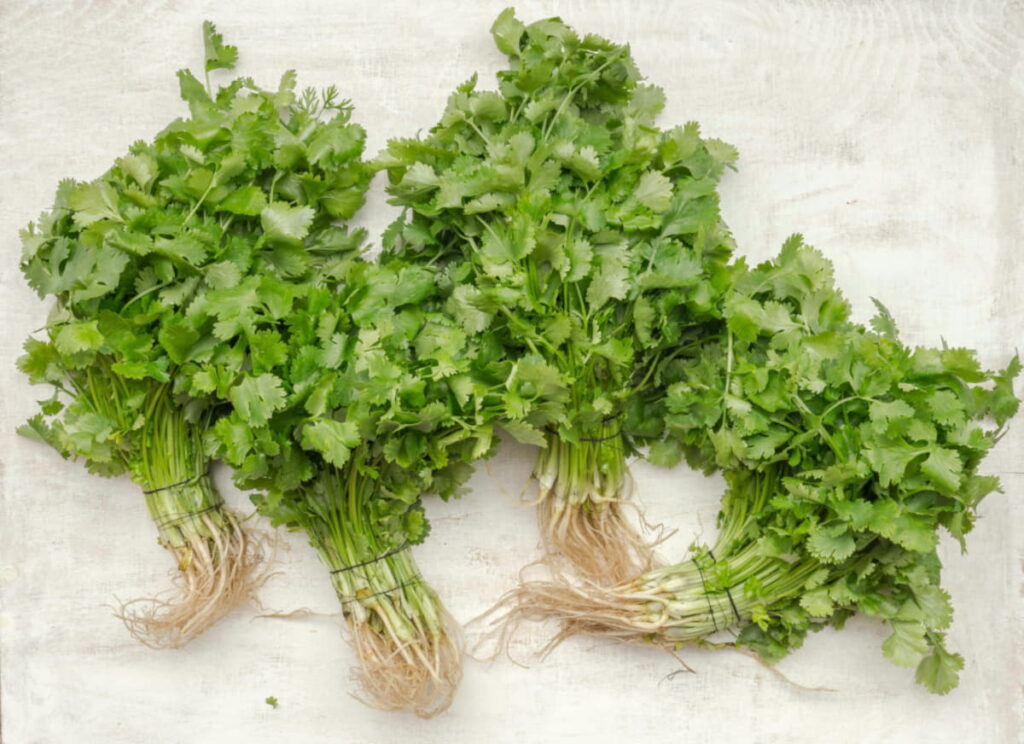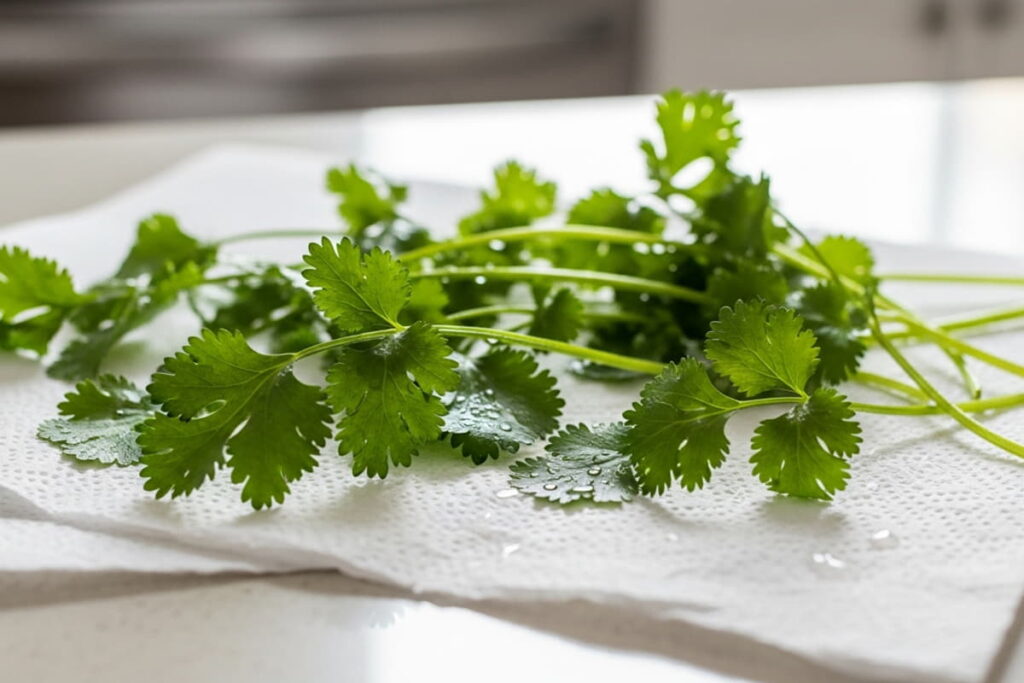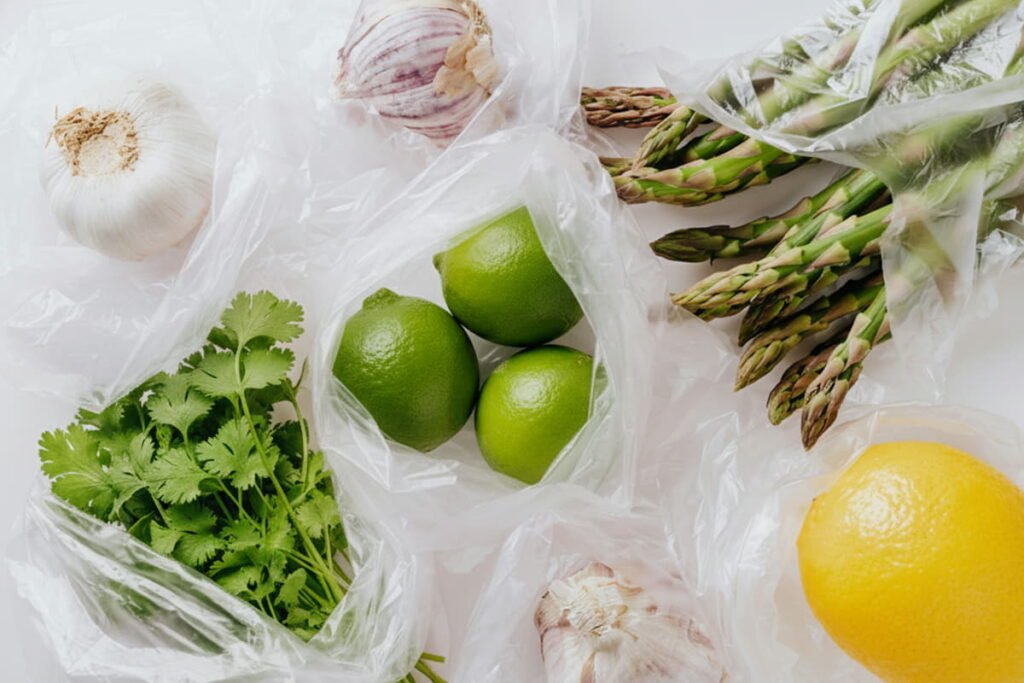
If you want cilantro to last longer, here’s the quick answer:
The jar method keeps it fresh the longest, but there are other options people swear by, depending on how they cook and store herbs.
I’ve tested a few methods myself and researched countless others, from chef tips to Reddit threads to actual food safety guidelines. And it turns out cilantro is one of those herbs where different approaches work for different kitchens.
This guide breaks down the storage methods real people use (not just Pinterest hacks), how long each one lasts, and which one makes sense depending on how fast you’ll use your cilantro.
Quick Answer: The Best Way to Store Cilantro
If you want cilantro to last the longest, the jar method is still the most reliable. Trim the stems, put them in a small jar of water, cover loosely with a plastic bag, and refrigerate.
Why it works: cilantro likes cold temperatures and very high humidity. Research from the UC Davis Postharvest Center shows cilantro keeps best at 32°F (0°C) and 95%+ humidity, and the jar method recreates exactly that.
The Penn State Extension also confirms that herbs last longer when stems stay hydrated and leaves stay in a humid environment with light airflow.
That’s why the jar method often keeps cilantro good for 10–14 days, while tossing it in the produce drawer gives you only a couple of days before it wilts.
Before You Store It: What You Should and Shouldn’t Do

Most people lose cilantro before they even store it, simply because of two small mistakes: too much moisture and not enough airflow. A few quick prep steps make a big difference.
Do this before storing cilantro:
- Remove any yellow, wilted, or wet leaves: These break down quickly and spoil the rest of the bunch, as damaged leaves provide an entry point for decay organisms.
- Give the stems a tiny trim: Freshly cut stems absorb water better (if you’re using the jar method), which works by removing dried-out tissue that clogs water-conducting vessels and allowing the plant to draw water to maintain turgor.
- Pat off any visible moisture: Cilantro hates trapped water, dry leaves last way longer, as prolonged wetness almost always leads to excessive decay and mold
- Keep it whole Don’t chop the leaves until you need them; chopped herbs degrade fast due to increased exposure to oxygen and accelerated loss of essential oils.
- Keep it whole
Don’t chop the leaves until you need them; chopped herbs degrade fast.
What not to do:
- Don’t wash cilantro before storing Added moisture is the #1 reason it turns slimy in 24–48 hours, as water on the surface encourages microbial growth
- Don’t seal it in a fully airtight bag while damp This creates the perfect environment for rot.
- Don’t leave it loose in the produce drawer It dries out and wilts quickly unless it’s contained properly, due to the dry air circulation common in refrigerators.
These quick steps set you up for success, no matter which storage method you choose next.
How to Store Cilantro (4 Real Methods That Actually Work)

Cilantro lasts longest when you control moisture and temperature, but you can do that in a few different ways. These are the five storage methods that consistently work, tested, researched, and backed by real-world results.
The Jar Method (Why It Works + How to Do It)
If you only try one method, make it this one. It’s the closest thing to giving your cilantro a tiny vase of life support.
How It Works
Cilantro behaves more like a delicate flower than a leafy herb. The stems keep drinking water after harvest, and the leaves stay crisp as long as the environment stays cold and humid.
The jar method takes advantage of both:
- Water hydrates the stems
- A loose plastic bag traps humidity
- The fridge keeps temperature low and stable
This setup hits the conditions that keep cilantro from wilting or yellowing early.
How to Do It
- Trim ½ inch off the stems.
- Place the bunch in a jar with 1–2 inches of water.
- Loosely cover the top with a produce bag or zip-top bag.
(Loose is important, you want humidity, not a greenhouse.) - Store in the fridge.
- Change the water every 2–3 days.
How Long It Lasts
10–14 days, sometimes longer if your fridge isn’t overly cold or dry.
Pros
- Longest-lasting method
- Keeps leaves crisp and vibrant
- Easy to see when it needs water
Cons
- Takes up a bit of fridge space
- Bag has to be loose or the leaves get slimy
Best For
People who cook a few dishes a week that use cilantro, tacos, curries, soups, garnishes, etc. It gives you plenty of time before the bunch goes bad.
2. The Paper Towel + Container Method (Low Effort, Solid Results)

If the jar method feels like too much work, or you just don’t have fridge space, this is the next best thing.
How It Works
Moisture is the enemy and the solution when it comes to cilantro. Too much = slime. Too little = shriveled leaves.
The paper towel method strikes a middle ground by keeping humidity stable without letting the cilantro sit in direct water.
How to Do It
- Gently wash and fully dry the cilantro.
- Lay it on a dry paper towel and roll it loosely (don’t compress it).
- Place the roll into a container or zip-top bag.
- Store in your fridge’s crisper drawer.
You can see the paper towel method in action below.
How Long It Lasts
5–7 days.
Pros
- Easier and less bulky than the jar method
- Helps prevent sogginess
- Good for partial bunches
Cons
- Doesn’t last as long
- If the paper towel gets damp, the cilantro wilts faster
Best For
People who use cilantro within a week or don’t want to commit to a jar taking up shelf space.
3. The Dry, Unwashed Bag Method (Best for Minimal Effort)

If you buy cilantro and shove it straight into the fridge, this is the optimized version of that.
How It Works
Cilantro lasts longer when you don’t wash it right away. Washing adds moisture, which speeds decay. Keeping it dry in its original bag (or a perforated produce bag) slows down wilting and gives you a few more days than just tossing it in the fridge.
How to Do It
- Do not wash the cilantro.
- Shake off any visible moisture.
- Place it in a breathable produce bag (or poke a few holes in a plastic bag).
- Store in the crisper drawer.
How Long It Lasts
3–5 days.
Pros
- Zero prep
- No paper towels or jars needed
- Prevents early sliminess
Cons
- Shortest lifespan
- Cilantro may wilt sooner without added humidity
Best For
People who plan to use the bunch quickly, like for a specific recipe within a couple of days.
4. Freezing Cilantro (Best for Long-Term Storage)

This isn’t for fresh garnish, it’s for cooking. Frozen cilantro won’t stay crisp, but the flavor sticks around beautifully.
How It Works
Freezing breaks down the cell walls, so the texture collapses.
But if you’re adding cilantro to soups, curries, stews, or marinades, texture doesn’t matter — only flavor.
How to Do It (Two Options)
Option A: Freeze Whole Leaves
- Wash and dry thoroughly.
- Spread on a tray, freeze, then transfer to a bag.
Option B: Cilantro Ice Cubes
- Chop cilantro.
- Pack into ice cube trays.
- Cover with water or olive oil.
- Freeze and store in a freezer bag.
How Long It Lasts
Up to 6 months.
Pros
- Long-term flavor storage
- Perfect for cooked dishes
- No waste
Cons
- Texture becomes soft
- Not suitable for fresh garnishes
Best For
People who cook frequently and don’t want cilantro going to waste, or anyone who buys Costco-sized bunches.
How Long Cilantro Really Lasts (By Method)

A quick side-by-side look so you know exactly what to expect:
| Storage Method | Typical Lifespan | Notes |
| Jar Method | 10–14 days | Can reach up to 3 weeks if humidity stays right |
| Paper Towel Bag | 7–10 days | May stretch to ~12 days; wilts faster in dry fridges |
| Store-Bought Clamshell | 5–7 days | Sometimes hits 10 days, but early sliminess is common |
| Freezing | 1–2 months | Quality declines after 3 months; best for cooking only |
| Countertop | 1–2 days | Might hit 3 days, but often wilts same day |
The Cilantro Method You Should Actually Use
If your goal is simple, make cilantro last as long as possible, stick with the jar method.
It keeps the leaves crisp, hydrated, and bright for nearly two weeks (sometimes more), and it’s the easiest one to maintain.
If you only need cilantro once or twice that week, the paper towel bag is the next best option: low effort, reliable, and fridge-friendly.
And if you’re someone who cooks with cilantro often (curries, stir-fries, soups, rice dishes), consider freezing some of it so you always have a backup.
For more practical food-saving guides like this one, check out my Storing Food Properly Hub, it’s packed with real methods, real tests, and actual results you can rely on.